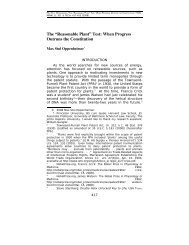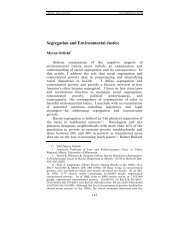An Organizational Approach to the Design of Patent Law
An Organizational Approach to the Design of Patent Law
An Organizational Approach to the Design of Patent Law
You also want an ePaper? Increase the reach of your titles
YUMPU automatically turns print PDFs into web optimized ePapers that Google loves.
6 VERTINSKY FINAL_JAD (DO NOT DELETE) 2/27/2012 2:20 PM<br />
2012] AN ORGANIZATIONAL APPROACH 257<br />
allocation <strong>of</strong> ownership rights provided by patent laws such as<br />
<strong>the</strong> Bayh-Dole Act, with its allocation <strong>of</strong> ownership rights <strong>to</strong><br />
private research institutions. 199 The one specific effort <strong>to</strong> address<br />
<strong>the</strong> increase in collaborative research and development in<br />
patent law may have created more problems than it solved because<br />
it failed <strong>to</strong> address <strong>the</strong> underlying structural challenges<br />
<strong>of</strong> different kinds <strong>of</strong> collaboration. This effort, <strong>the</strong> Cooperative<br />
Research and Technology Enhancement (CREATE) Act <strong>of</strong> 2004,<br />
sought <strong>to</strong> foster collaborations between public and private ac<strong>to</strong>rs<br />
by allowing exchanges <strong>of</strong> information in a way that increased<br />
<strong>the</strong> ability <strong>of</strong> each party <strong>to</strong> patent <strong>the</strong> results. 200 While<br />
seemingly a benefit <strong>to</strong> public-private partnerships, a failure <strong>to</strong><br />
consider <strong>the</strong> transactional structures <strong>of</strong> university-private<br />
company negotiations and <strong>the</strong> scope for opportunistic behavior<br />
by private parties resulted in rules that could systematically<br />
disadvantage <strong>the</strong> university partners. 201<br />
B. TAILORING THE CASE FOR TAILORING<br />
The U.S. patent statute creates a set <strong>of</strong> rules <strong>of</strong> general applicability<br />
which are <strong>to</strong> be applied <strong>to</strong> provide technology-neutral<br />
protection <strong>to</strong> any inventions that satisfy <strong>the</strong> legal standards<br />
prescribed. 202 This fits well with traditional approaches <strong>to</strong> patents<br />
and invention, with <strong>the</strong>ir abstraction from <strong>the</strong> processes<br />
<strong>of</strong> innovation. The one-size-fits-all approach is increasingly at<br />
odds, however, with evidence that patents perform differently<br />
in different market and non-market contexts. Additionally, patent<br />
law has not yielded <strong>the</strong> hoped for flexibility in addressing<br />
199. The Bayh-Dole Act <strong>of</strong> 1980 and <strong>the</strong> Stevenson-Wydler Technology Innovation<br />
Act <strong>of</strong> 1980 reflect U.S. patent law efforts <strong>to</strong> facilitate innovation in<br />
contexts <strong>of</strong> government-funded research, by non-government research entities.<br />
See 15 U.S.C. § 3701 (2006); 35 U.S.C. § 200 (2006). The effectiveness <strong>of</strong> <strong>the</strong>se<br />
laws is still under debate. See F.M. Scherer, The Political Economy <strong>of</strong> <strong>Patent</strong><br />
Policy Reform in <strong>the</strong> United States 18 (John F. Kennedy Sch. <strong>of</strong> Gov’t, Working<br />
Paper No. RWP07-042, 2007) (suggesting alternatives <strong>to</strong> <strong>the</strong> current patent<br />
law regime).<br />
200. The Act expands <strong>the</strong> universe <strong>of</strong> information that will not be considered<br />
prior art when seeking patent protection for <strong>the</strong> fruits <strong>of</strong> <strong>the</strong> collaboration.<br />
See, e.g., Cooperative Research and Technology Enhancement (CREATE)<br />
Act <strong>of</strong> 2004, Pub. L. No. 108–453, 118 Stat. 3596 (amending 35 U.S.C. § 103(c))<br />
(protects information shared as part <strong>of</strong> a collaboration from being considered<br />
prior art for patenting purposes); Bayh-Dole Act <strong>of</strong> 1980, 35 U.S.C. § 200<br />
(2006) (providing for ownership over inventions developed using federal funding).<br />
201. See Vertinsky, supra note 183, at 68.<br />
202. See, e.g., Burk & Lemley, supra note 22, at 1576.






